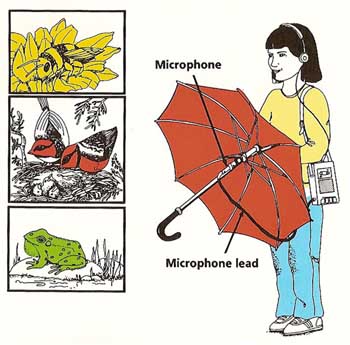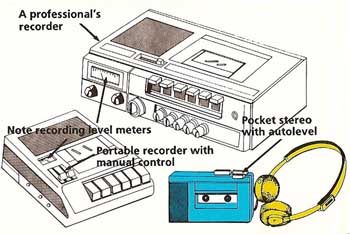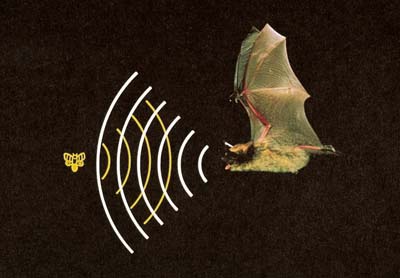SOUNDS INTERESTING: The Science of Acoustics - 6. Animal Chatter

Figure 1. The howler monkey makes some of the loudest sounds heard in the jungle.

Figure 2. Recording animal sounds (1).

Figure 3. Recording animal sounds (1) ().

Figure 4. Hummingbird.

Figure 5. A bat finding its prey by echolocation.
Among the most unusual and varied sounds on earth are those made by animals. Monkeys chatter and shriek, birds chirrup and squawk, and bullfrogs produce an amazingly loud noise to attract mates and drive away other males during the breeding season.
The bullfrog passes air back and forth from its mouth to its lungs across its vocal cords. Some of the air goes into special sacs at the bottom of its mouth. These sacs then blow up like a balloon and act like a sound box to amplify the vibrations of the vocal cords.
Most animal sounds, like those of the bullfrog, serve as a form of communication. They may warn, attract, or help an individual to identify others nearby (see Figure 1).
Whales and dolphins produce an especially complex variety of sounds. So much so that scientists have suggested they may have an advanced language of their own. What is certain is that these creatures can call to one another with sounds that are both below and above the range of human hearing. Dolphins seem to have another use for the ultrasonic "clicks" they are capable of producing. With a powerful, narrow beam of ultrasound they can stun a fish and then grab it in their jaws before it has a chance to recover.

Capturing Animal Sounds on TapeYou will need:
What to do: Place the tape recorder and microphone outside in the area you are interested in. This might be, for example, a flower bed visited by bees or tall grass in which crickets live. Turn on the recorder and wait some distance away (see Figure 2). After you have made the recording, add a short commentary that includes the date and place of the recording and the weather conditions. Some animals perform only under certain conditions and your tapes will be of much greater value if you record full information.
Taking it further:
Observe closely the behavior and habitats of the animal you wish to record. This will help you to set up your equipment in the best position and at the best time of day.
Another way to improve the quality of your recordings is to attach the microphone to the stem of an umbrella, as shown in Figure 3. The umbrella acts like a large sound-gathering dish. It focuses the sound waves coming from a particular direction to a single point. Hold the microphone against the stem of the umbrella, facing into the dish, about 6" from the top. To position the microphone exactly at the focus of the dish, use headphones attached to the tape recorder so that you can monitor the sounds being picked up. Point the umbrella stem at a distance to the source of the sound and adjust the microphone's position until the sound seems loudest, then tape the microphone to the stem. Using this equipment it should be possible to record the sounds of a single animal, such as a bird singing in a tree, even if it is a hundred yards or more away.
Noise is always a problem when recording outside, and it is often worse than we think because our ears and brains are very good at cutting out unimportant sounds. A microphone, on the other hand, picks tem all up. Wind is the biggest nuisance, but this can be partly overcome by putting some fine material over the microphone. The material must be held away from the end of the microphone – for example, by a wire frame.
The quality of recordings depends much upon the quality of the recording equipment. Most cassette recorders have an automatic volume control, but this can be a disadvantage for wildlife recording because animal sounds often come in sudden bursts. This does not give an automatic system a chance to adjust itself. A recorder with a manual recording level control is better since you can adjust it to the volume of sound it is picking up.
Many types of microphones are available. They vary in shape, size, sensitivity, and cost. The best for general use is a cardioid microphone, also a unidirectional microphone. It tends to dampen out sounds not coming from the direction in which it is pointed so is especially useful for recording birds. |
Strange Sounds, Strange Ears
Many animal sounds are not produced in the throat but by other parts of a creature's body. The hum of a hummingbird, for instance, is caused by the rapid beating of the bird's wings – up to fifty times a second in some species. (see Figure 4) These continuous wing movements set up vibrations in the surrounding air which reach our ears as the familiar low-pitch drone. If you have hummingbirds in your area, set up a feeder and listen to how the note of a hummingbird's hum changes as the bird stretches its beak forward to feed.
As well as producing sounds in unusual ways, animals may also have ears in the oddest places. A grasshopper, for example, picks up sound through two slit-like openings just below the first joint in its front legs. The sound then travels to two small air pockets, the vibrations of which are detected by a sensitive lining.
Sounding Out Prey
Several animals use sound rather than sight to find their way and their food. Most bats sleep by day and hunt by night. As they fly, they give off high-pitched squeaks, usually beyond the range of human hearing. The waves of ultrasound from the bat bounce off obstacles and insects and return to the animal's large, sensitive ears. From the echoes, the bat is able to work out the exact distance and direction of whatever lies in its path (see Figure 5). Ultrasound produces a much sharper view than ordinary sound waves would. Dolphins also use this method, known as echolocation, to find their prey.
 |

